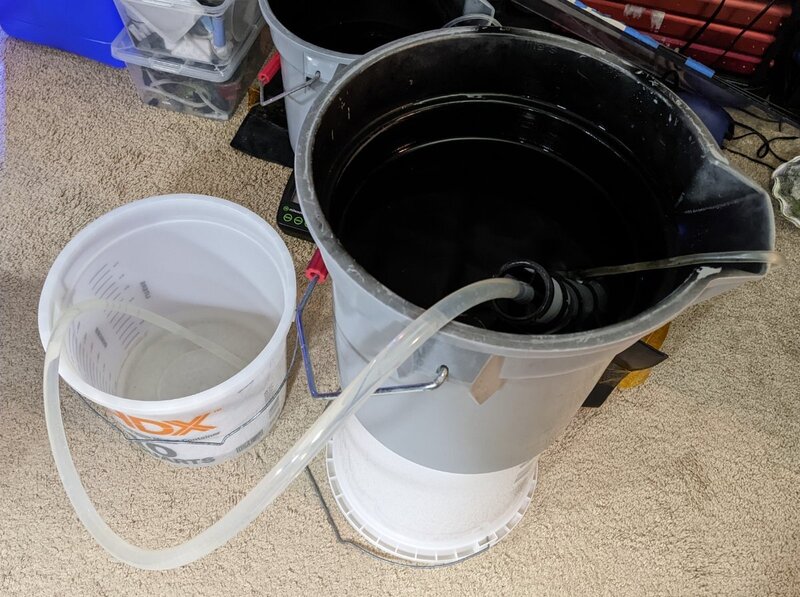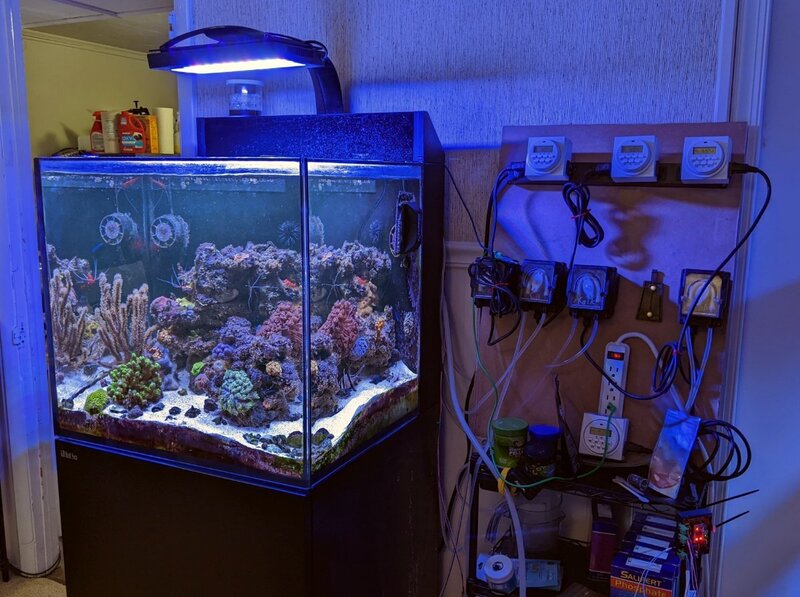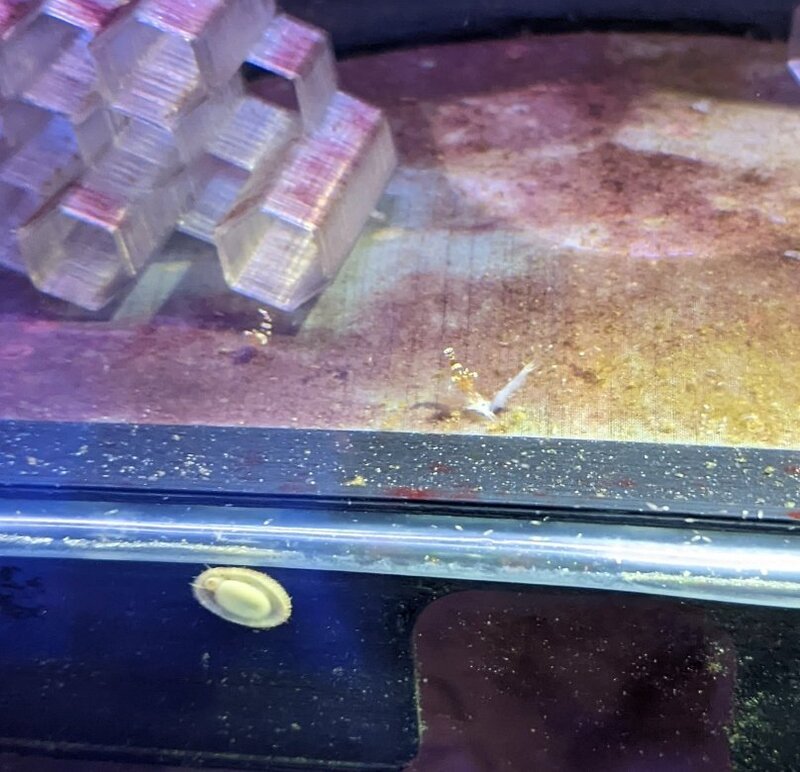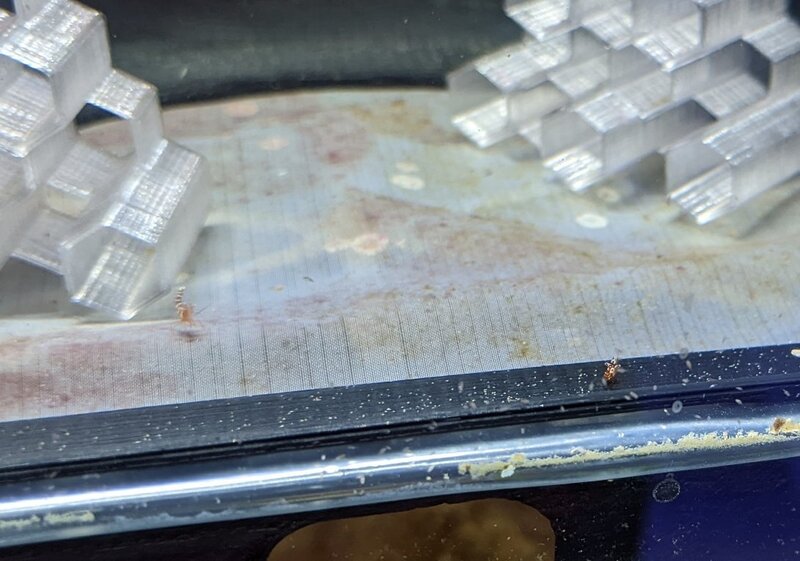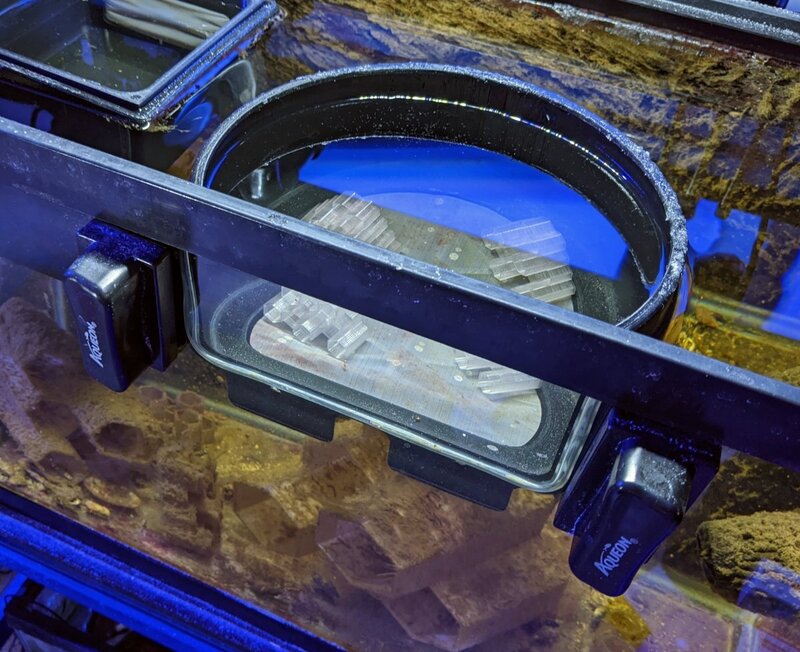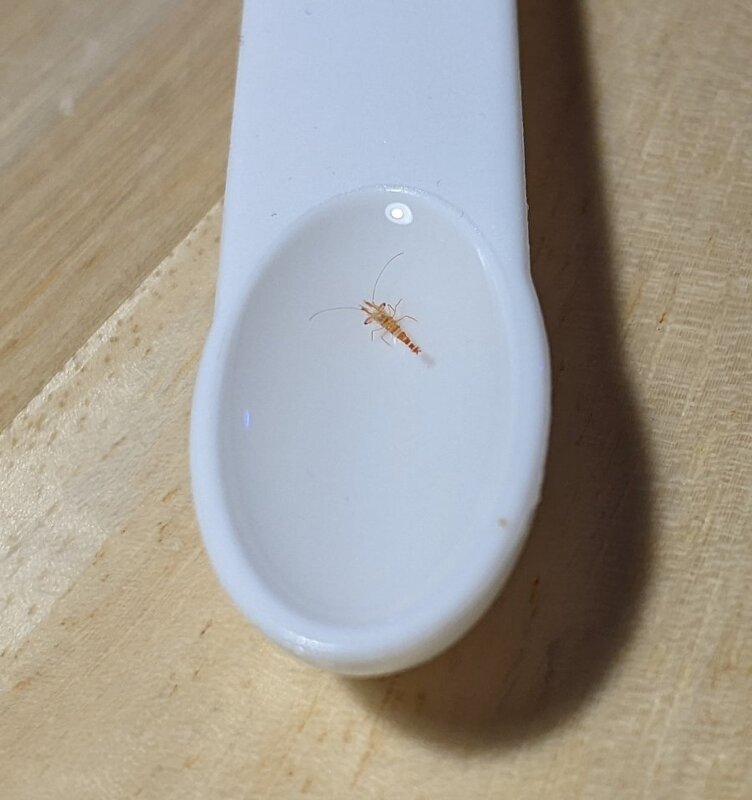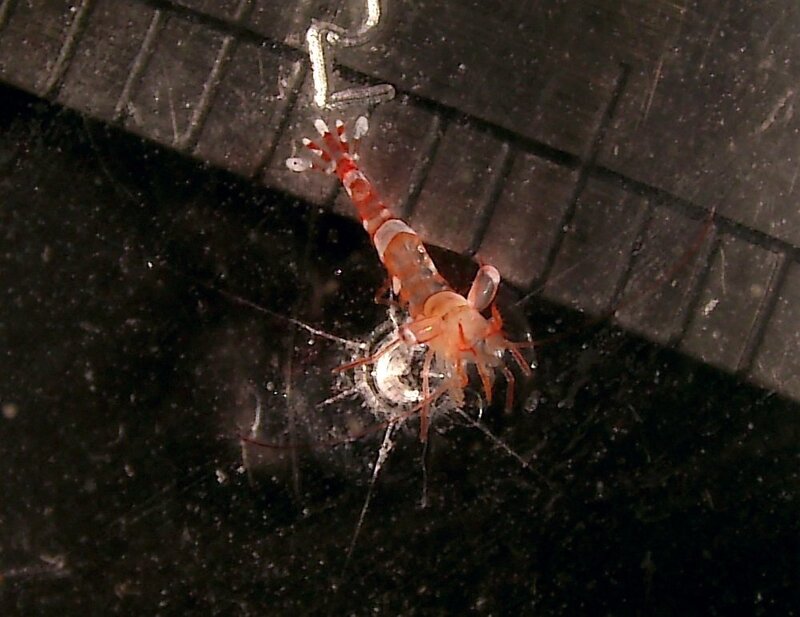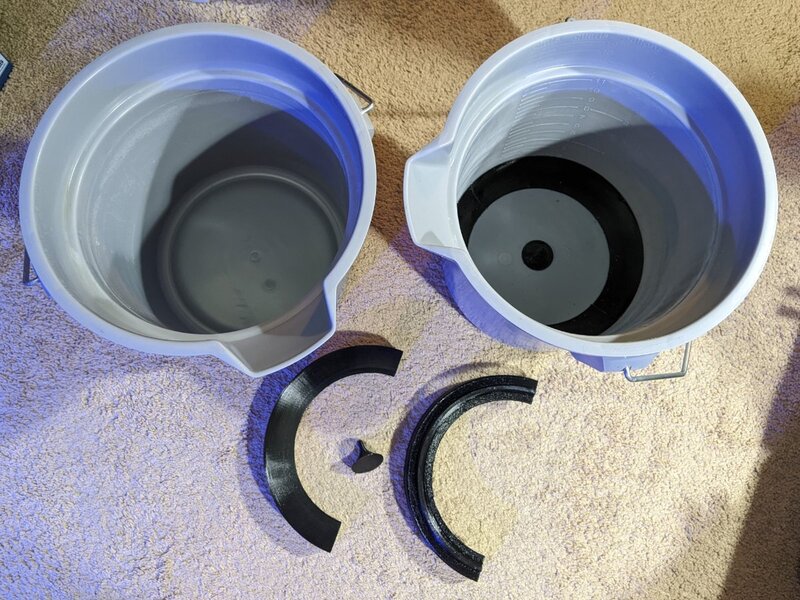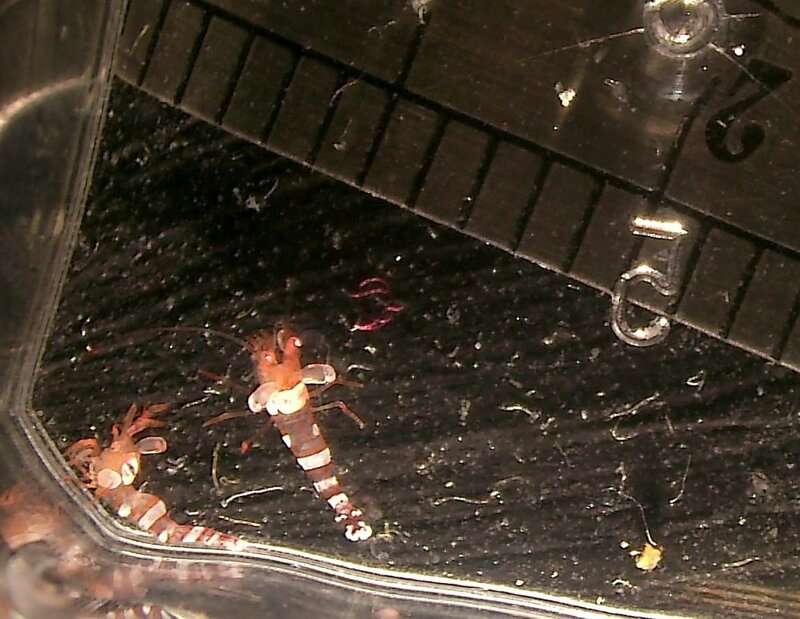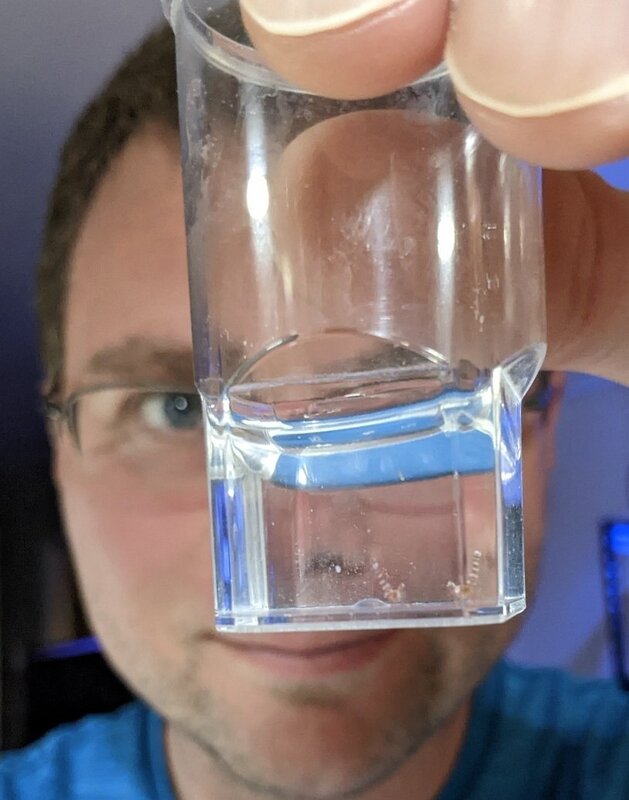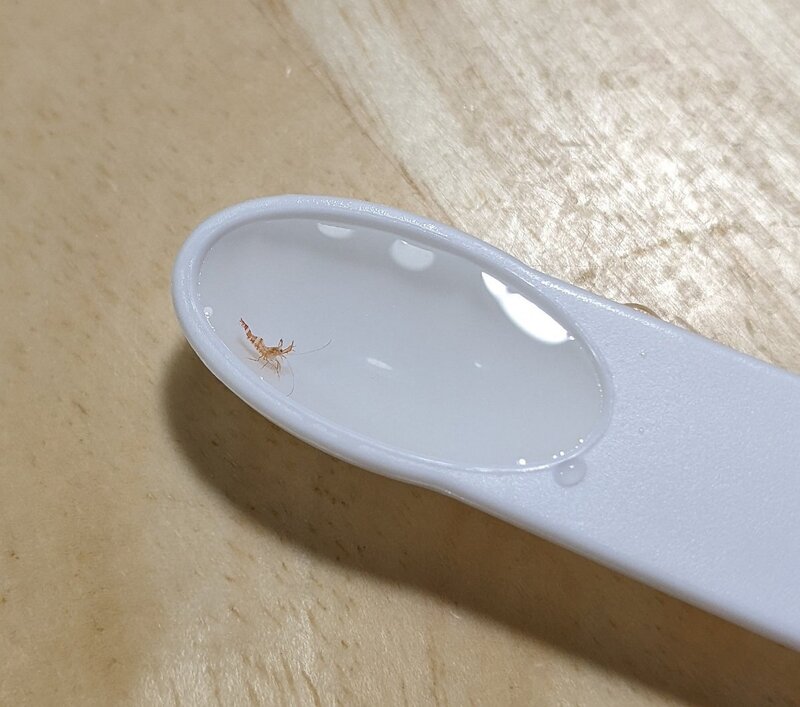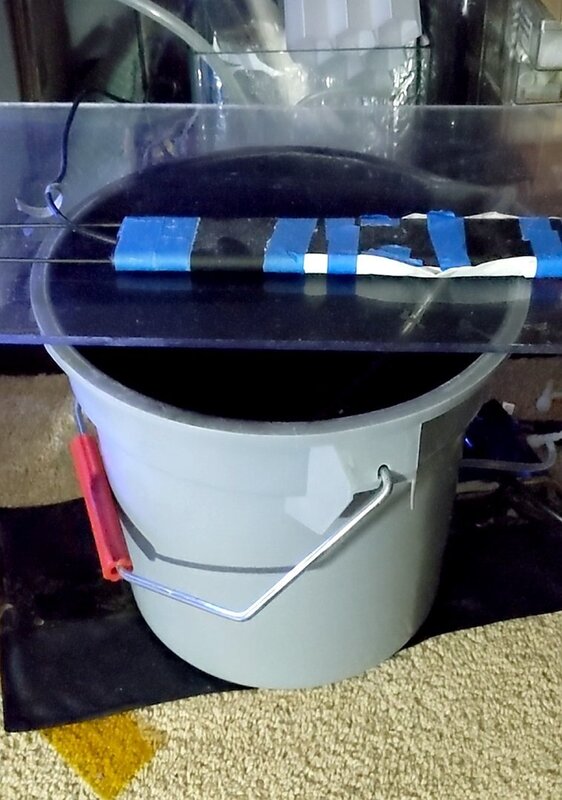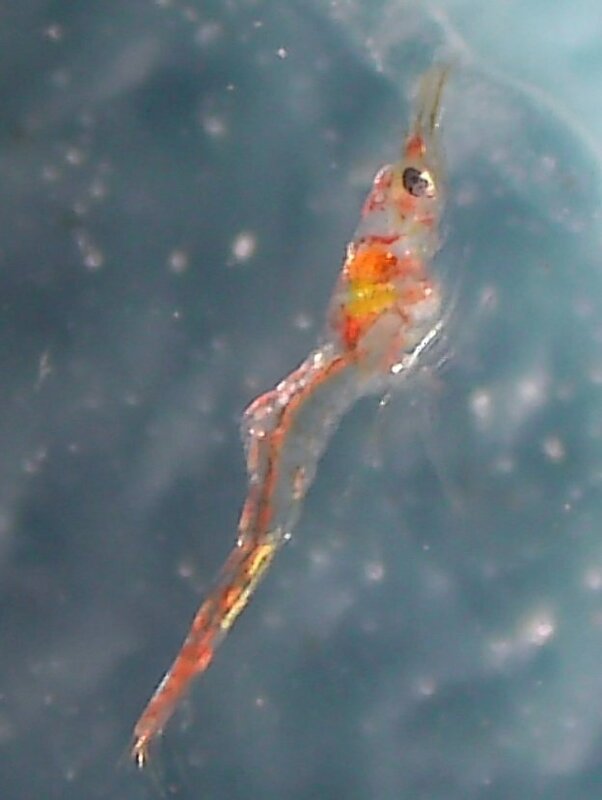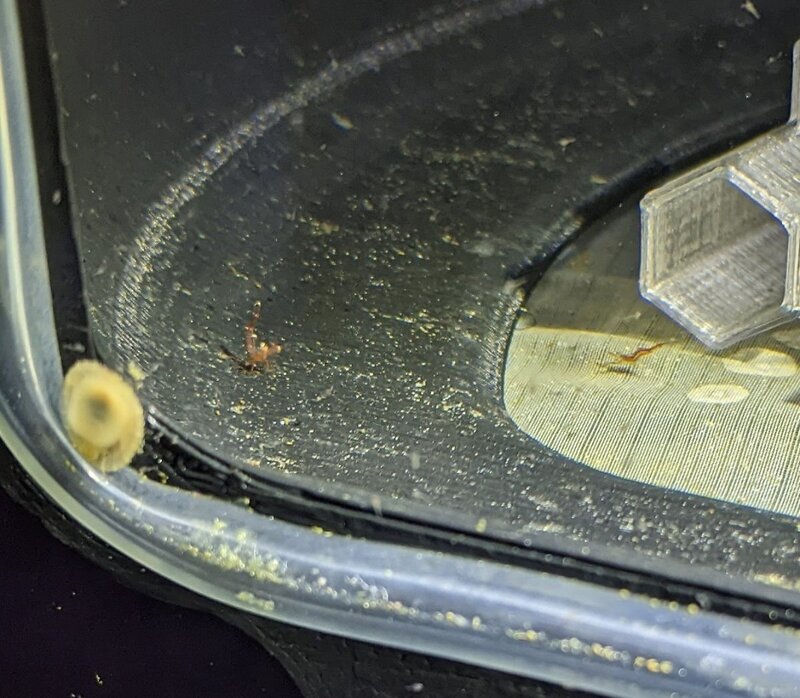-
Posts
748 -
Joined
-
Last visited
Content Type
Profiles
Forums
Gallery
Events
Store
Everything posted by DaJMasta
-
Especially if the glass is reasonably thick (> 1/4") tightening it a little with pliers is probably fine to do (try not to twist the glass off the rotation axis). Silicone can be used for a seal (it's not ideal, but it does generally work), you could probably cut the PVC and just replace the bulkhead and the bit going into it, and if it's on the order of a drop every now and then instead of a more continuous seeming leak, it may just seal itself with debris or salt creep. The glass should be very even, if there is any version of this that would be hardest to fix, it would be if something went wrong drilling the tank and there was breakout under the flange of the bulkhead that managed to get out from under the seal - unlikely, but even then possible to fix by drilling for a larger bulkhead and replacing it (with a reducer as needed.)
-
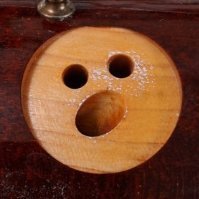
Salinity checking journey - finally landed on TM Hydrometer
DaJMasta replied to Gatortailale's topic in General Discussion
Interesting, I may end up getting one, but the pen style also needs a larger sample (though maybe an ounce in a shotglass would do.) I wonder what benefits there are to electrical conductivity vs. refractometry vs. specific gravity (a hydrometer.) I feel like most of the professional/research solutions I hear about are electrical conductivity based, but that may just be because when your probe is fully immersed in water, the alternatives are just more complicated to manage than dealing with whatever problems are inherent to EC measurements. -

Salinity checking journey - finally landed on TM Hydrometer
DaJMasta replied to Gatortailale's topic in General Discussion
It seems like a lot of people are in agreement that a properly calibrated hydrometer is the best choice, but it's so much more effort and saltwater required to test each time. For my use case (checking salinity maybe a dozen times a week for small saltwater batches, sometimes as small as a gallon), I've been pretty happy with my Milwaukee MA887, but it's by no means perfect. I will do a minimum of three tests, with some extra volume in the well for the first test to help find thermal equilibrium with the sample and get any residual salt out of the well. I haven't had issues with long term drift or stray light, but it's not uncommon to see salinity change over subsequent readings as it comes up or down to temperature and I see the occasional reading increase with every measurement (to absurd levels with more checks), only to empty the well, put in another sample of the same stuff, and get a proper reading - not sure about that one. What I'd really love, though, is something that would give me more than 1ppt worth of resolution. A tenth of a ppt would make it much, much easier to see long term salinity trends in the tank - which I know mine has because of live phyto/copepod dosing, and the 1ppt resolution of the MA887 (and virtually everything else) seems too coarse. I've also had some issues with handheld optical refractometers, and I think it's actually been physical bump related, though even with a gentle tough, I ran into drift issues even in the course of a week or two. The electronic one needs just a few drops, a few less steps, and seems to be both consistent and stable provided you are doing several tests on the same sample and retesting if you suspect outliers. I got my hands on a Reichert-Jung ABBE Mark II, but while it powers up, it doesn't seem to respond to the control buttons, so I've got some poking around to see if it actually works and then whether this used one performs as one should. -

Need advice - algae and cyno; nitrate 0, phosphate 0.3
DaJMasta replied to Kathryn Lawson's topic in General Discussion
I do think the cyano will go away as the tank rights itself, but the maintenance is tedious and it does have the potential to smother coral that isn't doing well, so personally, I'd probably use the chemiclean. My preference for using it is to get as much of the cyano clumps out right before treatment, then dosing around the normal dose (a little lower seems to usually have a good effect), and leaving the skimmer on during, but not collecting the skimmate and just turning the level way down - I had an issue with a treatment a while ago where having an AIO and not having the skimmer on meant the oxygen levels sort of tanked on the first day, and the extra agitation of a not-collecting skimmer would have fixed it. While it is sort of a band aid, it does really work and relatively quickly, so it will help give you a leg up on the maintenance side for some weeks to come, at least, and as the water changes continue, it will get out and let things settle once again in time. -
Between the slight blueness of some of it and the branching (not a lot, but not just individual strands), I'm pretty convinced that's bryopsis. That also means it will likely persist regardless of phosphate level. I've heard basting the area so detritus doesn't accumulate it can help, but you'll probably need a dedicated bryopsis eater or a chemical treatment to actually get rid of it. I've had luck with fluconazole (Flux Rx in my case), but there should be other options that are available (and maybe lettuce slugs/sea hares could be one of them?)
-
Are you sure it's hair algae? If you've got 3 tangs and the algae keeps coming back, I'd suspect bryopsis. Sometimes the branching structure doesn't look as fern like as some pictures, too, but often there are tiny blue flecks on some of the hairs in normal reef lighting. Between the nori and the frozen, I could understand some phosphate buildup, especially without a bunch of corals and things to absorb them, so having some kind of phosphate management system (GFO, lanthanum chloride, etc.) is what I've come to expect. On my smaller tank, my phosphates tend to be high, but I'm managing them with regular (every week or so) PhosBan-L dosing, though it seems larger systems tend to prefer GFO in a reactor as you're doing. For the hair algae (or bryopsis) you could try a treatment like flucanozole to get rid of it, then keep up the phosphate management and see if just getting it out initially can keep it away.
-
I don't think so, from what I understand, phosphates will leech out of rocks for a time, but most that they absorb is bound up in a way where it doesn't come out in the water again - there was a study done recently iirc but I haven't been able to find it. The short of it was that in the short term (a matter of days) it could let a bunch back out into the system, but it basically tapered off asymptotically, so there was effectively negligible release after a week to a couple of weeks. I think both calcium carbonate based rock and sand was tested and the results were the same. So, personally, I'd continue some kind of phosphate management, and if rowaphos has been doing the job and you've got the hardware for it, it sounds like a good choice.
-
Which nems? Most things that eat them aren't going to eat all varieties of them.
-
Just shrimps being shrimps Here's also the siphon tool I made for changing water in these buckets. It's basically just a wide expansion collar for the tubing, covered in mesh, and tall enough to reach almost to the bottom of the fill line on the Brute buckets I've been using (taller doesn't fit well in normal sized printers.) https://www.thingiverse.com/thing:6467504 You print the interior part, 5 rings, and sandwich a sheet of aquarium safe mesh (250 micron nylon, in my case) around the interior part with the rings and a few drops of superglue. Then you just siphon through it as normal into a bucket, though I occasionally baste the screen with some of the siphoned out water just to be sure no larvae get caught on the screen from the suction force. It lets you change water with minimal attention paid while draining, and unless you use pretty coarse mesh, keeps all the larvae in.
-

Glass thickness and arm mounted G4 radion
DaJMasta replied to YHSublime's topic in General Discussion
It is a lot of weight, I don't know of particular rules of thumb, but I wouldn't do an XR30 on thin glass (maybe under 10mm), personally, and would probably want at least 1/4" for an XR15. You may be able to get away with sandwiching another material over a wider surface area under the clamp, but it probably wouldn't look great, having something else to hold it up would be best. The issues are the twisting force that will be right around the clamp when installed, but also the stress on the seams from the bending of the panel. Remember that any bump to the tank or light would temporarily increase these stressors, since the light is a weight on the end of a cantilever. You can reduce the force by sliding the light as close to the elbow as possible, but it's not going to be a massive reduction, an XR30 still weighs a bit. -

strange problem: varios 6 pump makes a few spins then stops
DaJMasta replied to astroboy's topic in General Discussion
My guess: fault protection. Briefly turning on only to turn off says that there's some mechanism in there to prevent damage when running it when there's a problem that's kicking in and stopping it prematurely. Whether this is a real fault being caught or the fault detection mechanism being faulty is harder to gauge, and exactly what kind of protection is triggering (probably not heat since it's so quick, but maybe rotation detection or current detection from the driver)... much harder to say. If there is any kind of error code/status LED/app message, that's probably the best way to determine it, but that sort of falls to how transparent about their hardware they want to be with the consumer as to whether it's even shown. -

DaJMasta's 45G AIO Cube Mixed Reef
DaJMasta replied to DaJMasta's topic in Dedicated Tank (Build) Forum
Thanks, I think so too. For the losses over time, I think it's both looking good and is on a positive trajectory. About a month ago I was still getting regular buildup (though not everywhere) of cyano with a smidge of dinos, and I read in another thread on here that the high phosphate (and it's been chronically high) specifically could be encouraging it. So I've been treating a couple times a week with lanthanum chloride and measuring to try and keep it down more consciously, and in the last week there's been basically none of either after a small water change, plus the algae growth on the glass is down a bit the last few days, too. They had never been dealbreaker kinds of problems, but it definitely looks nicer now. I also think that the couple of fluconazole treatments I've done in years past have lead to some buildup in the system. I had noticed during treatments that I would loose egg masses that were carried by shrimp and even by the male cardinal, but I also just wasn't doing a lot of water changes in general. About two weeks ago the cardinals spawned for the first time in two years - the eggs weren't carried for long, but I had thought they were altogether done. It could be that a few more water changes over the next couple of months could carry out enough of whatever's built up to increase spawning/fecundity rates, but for now it's only a hunch. -

DaJMasta's 45G AIO Cube Mixed Reef
DaJMasta replied to DaJMasta's topic in Dedicated Tank (Build) Forum
Well, it's been a heck of a while, but while there have been continuous changes, it's still running. Lost more critters than I would like - most notably the clam and some of the SPS colonies - but there is quite a bit that has kept going strong and that's been growing into a decent size. Had an almost two week vacation at the beginning of the year and that was the crunch I needed to finally do some automation, albeit crudely. Setup an array of dosing pumps to take care of most of the basics and built a little custom ATO with some spare parts and the wet components intended for the ATO of the full on controller I *still* have plans on building. Have some software revisions and testing to go, but it lasted the break without issues and I think is a reasonable design. The current messy support system looks like this: And the projects continue, at the end of the last year I got a hydrophone with the intent to listen in on what was going on in there, and I've started some recording. Here's one at feeding time a few days ago, and while they're not a noisy bunch, you can hear some interesting stuff: -
Not soon, these two I plan on keeping as I want to have a little colony going (this should get me to 6, I think, but I may get another for a little more genetic variety and numbers), and if I can get some to settle and grow out a bit farther in the future (looking like maybe 2 months post settlement for reasonable size?), I certainly can. Haven't seen a spawn in a couple of weeks, so haven't yet started another batch. This is both of them this evening (four weeks post settlement), one eating a hikari mysis - still much smaller than it, but getting bigger and really clearly a sexy shrimp from color/shape/patterning.
-
Thanks, I should have a good bit more to write up, but part of my goals are to share tools and methods. I've learned most of what I know from various internet resources (logs, posts, papers, videos, etc.), so I'm trying to contribute to that knowledge now that I'm finding some success. A couple days ago they started getting easier to notice in the tank - I think the color is filling in between the white spots so they are more contrasty against the bright background. They're also a little easier to photograph (starting to get the phone to actually be able to focus on them....) And today, I've uploaded the vessel I'm raising the juveniles in. It's another 3d printed tool that uses a fine mesh base to allow for water circulation but no larger creatures (amphipods, fish, tiny sexy shrimp) can really get through. I'm using a 200 micron mesh, so a good number of added copepods are still in the chamber too. It prints in two pieces, then you glue in the mesh, held down by one part, and run a length of silicone airline tubing (the silverish looking stuff at the bottom of the last pic) which takes care of making a seal against the glass. Once everything's assembled, it's held onto the side using aquarium magnets. The models are available here: https://www.thingiverse.com/thing:6444788
-
Small update for today: The two seem to be going as normal two weeks post settlement. They're somewhat less afraid of me than their parents, but similarly, they don't like bright light shined on them and they quickly scoot sideways to get out of the way. The coloration or size doesn't seem to have changed much in the 4 days or so its been since I got back, but here's the smaller one of the two (lower left in the microscope picture with both.) Also, this is the 3d models for the little additions to a Rubbermaid Brute 3 Gallon bucket that I used to raise the larvae. You print two of the little crescent pieces to fill in the outer ridges and round the bottom, then you put in a central bubble anchor and glue them down. I used aquarium silicone and it's not amazing as an adhesive, but it does the job. I also painted the inside black (epoxy paint also doesn't stick great), and it's probably worth sanding the bucket with ~300 grit sandpaper or so to help adhesion at least somewhat. https://www.thingiverse.com/thing:6436667 Then to finish the vessel, you add an airline with a valve to control airflow through the central anchor (drives a light toroidal flow pattern in the vessel, bubble rate = flow rate), and you put it on a water resistant seed warming mat for a little bit of heat (it's not very strong and not temperature controlled, so this only will work well in a temperature controlled space). For a bit more heat and a little cleaner look, use a heat safe tape (I used Kapton) to make the warming mat a sort of blanket to wrap around the bucket.
-
Go to the Waikiki aquarium (walking distance from the shops and hotels) and reserve a behind the scenes tour. It's a small facility, so walking the exhibits will only take an hour or so, but the tour is at least as long and takes you through most of the back rooms to see the equipment, sumps, live feeds, QT, etc., and is very well guided, plus it's only a small fee extra. They've got corals they've had in captivity since the 80s (and some of them are huge) and they've still got the shell from the captive growth world record for a giant clam (about 45 years and two feet across.) Of course, in the ocean is also great, and there are a lot of more sheltered areas and boat tours for even beginning snorkelers to be able to see quite a bit.
-
I've got some similar looking ones in one tank, at their peak numbers they look a little messy and they appear to be photosynthetic (they'll go for well lit surfaces during the day), but I haven't had any particular issues with them and like you, their numbers have usually been pretty low and have fluctuated. They don't seem to crawl around on corals.
-
Right around the new year I had my first sexy shrimp larvae settle (one on the 31st, one on the first) and then I immediately went on vacation. Came back a week and a half later and the two are going strong and are starting to fill out their coloration, so it's time to write it up! I've made maybe a couple of dozen attempts and found that they didn't do great in small vessels and that the copepods I've been raising alone weren't sufficient for nutrition, so I've moved to external vessels, hatch artemia nauplii to supplement (maybe) be the majority of) food offerings, and have been trying to do regular near complete water changes. In an effort to make my attempts more repeatable and iteration more continuous, I've also been documenting my attempts in simple logs, and I'll be sharing as much detail on my initial attempt and changes made for subsequent ones - it will just take a bit to gather everything. So for starters, here are both of my little shrimplets from yesterday: That ruler on the bottom is showing millimeters, but in an other format: This is from the first of 2024, when the second started to settle You can still see a mostly straight back on the newly settled shrimplet And this was the first one to settle on the 31st In a very abbreviated history that I hope to detail later, they started here (~1 hour post hatch, in these two's case, the night of November 26th): And were raised in this glamorous setup on the floor: I'll be sharing the 3d printed parts I used for the rearing vessel (a three gallon brute bucket spray painted black), as well as the little tool I made to do water changes (which works alright, but probably can be improved.) The larvae were initially collected in this https://wamas.org/forums/topic/102446-3d-printed-pelagic-larva-and-egg-collector/ but I was also getting a bunch with a turkey baster and putting them in (some ambient room light and they aren't that phototactic.) And finally, some details of this, my first successful run: Larval Attempt Log - Sexy shrimp 11.27.23.pdf
-

Power going to be off 8hr - what to do
DaJMasta replied to FrontosaTony's topic in General Discussion
It's all been covered, but +1 to circulation being the key, by far, and that air pumps are sufficient for that. Battery integrated pumps are fine, but if you want more flexibility/longevity, you can get ones with external battery clips, generally 12V, which are made to connect to sealed lead acid type batteries (like car, marine, UPS, and mobility scooter batteries), and more recently, there are lithium iron phosphate based battery stations which are very convenient and have better charge density (smaller, lighter batteries last for longer). While using a LiFePO4 battery station you can just plug stuff into the AC outlets (though this is overall less efficient), or directly use the DC output for running a bubbler or similar. Also gives you some flexibility for other devices if you need them. -
What are your water parameters like? How much are you feeding? What kind of nutrient export do you use (skimmer, regular water changes, chemical media, scrubbers, etc.) Especially if it's a slow onset, you've got more nutrients going in than out. Often increasing removal can help, but reducing input can too, and adjusting other parameters (light intensity, stocking, dosing, one-time treatments) can have a significant effect. So there should be a lot of potential ways to solve this problem, you've just got to decide on one. Provided your phosphate and nitrate levels are reasonable, I would, personally, look towards livestock as a potential management/solution. You've got a good bit of space, so one of the common herbivores (a tank, foxface, etc.) is probably viable unless would conflict with your existing livestock. Smaller fish like a lawnmower blenny could be a helpful and interesting addition, and of course there are a whole slew of invertebrates which could help (snails, emerald crabs, urchins, etc.) If your corals don't need as much light as you're providing, turning down the lights or shortening the schedule could be an option, and then there are chemical options for nutrient removal and as an algaecide if it comes to that. A skimmer, scrubber, algae reactor, refugium, or other equipment can also be an effective option, but it may be a more costly and slower acting one that may not be necessary.
-
It seems like most peoples' experience with chromis is that they end up as one after a while - no personal experience and I don't know I totally buy it, but keeping a number of them seems to be tricky between disease (uronema) and aggression. With banggais, some people say the same, and some people seem to manage several. I think if you add a group of similar size and have enough spaces for them to shelter in (not caves, but crevices or overhangs) you'll be alright, but the universally safe choice is a single one or a pair. Pajama cardinals seem to be more tolerant of loose groups, but probably less active (and they can get surprisingly big.) Algae blennies should be just fine but may compete for space with other ground dwellers. In my experience, dragonets are no issue, but sand dwelling gobies can not get along with sand dwelling blennies (not necessarily fighting, but irritation, at least.) In terms of number of fish... you've got plenty of space. If they're friendly, smaller, and don't occupy the same niches as what you've already got, you could probably get a dozen or two more in there provided your feeding and filtration are up to the task. While probably not an ideal to strive for, I've got 10 in my ~45 gallon now and I'm actually down a couple in the past year - takes a lot of food and making sure they can get along, though.
-
The red/pink ones look like spaghetti worms to me still. They'll have a thicker body and then a cluster of thinner red tentacles for one worm, and usually they'll bury in the rock or sand the short tentacles will come out after dark.
-

Is there a way to visually tell alkalinity/calcium?
DaJMasta replied to YHSublime's topic in General Discussion
Take a little out and put it in the tank - white cloud in the water is alkalinity (especially if it's soda ash). My calcium also seems more viscous at standard concentrations (though magnesium is even more viscous still). Could also take like 100mL of salt water or something and add a few drops and measure.



